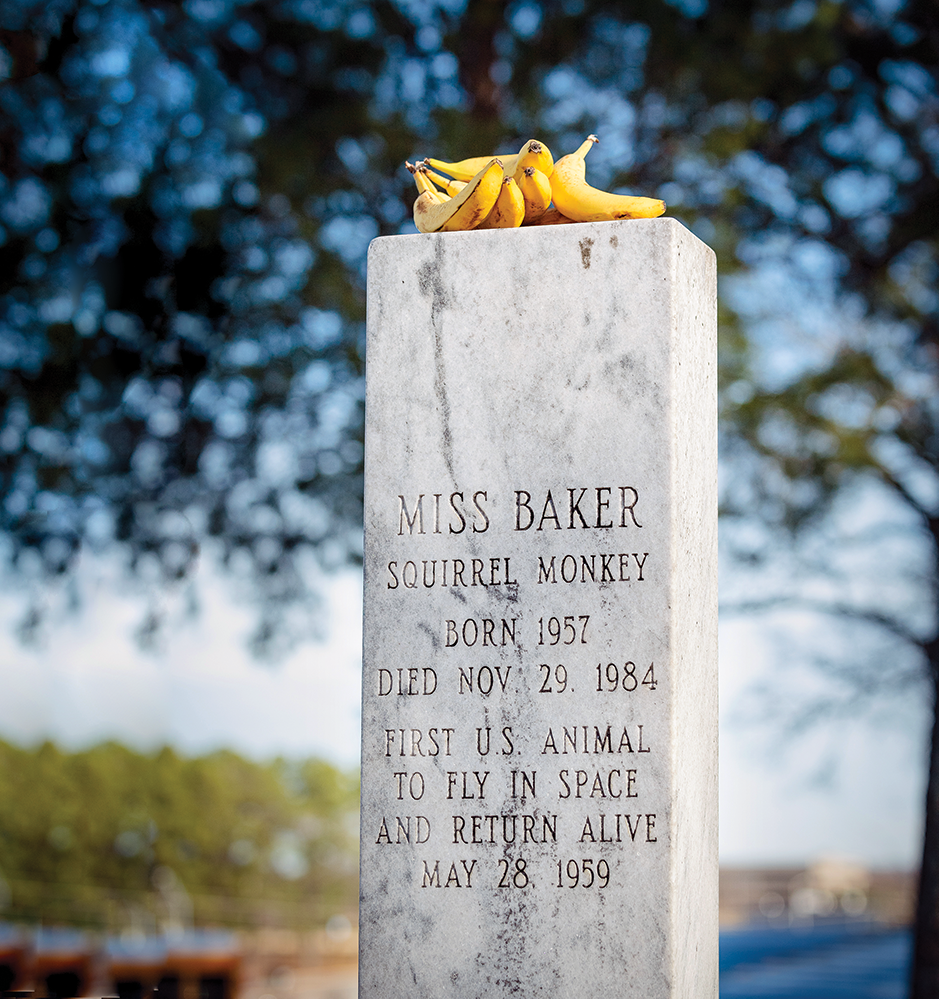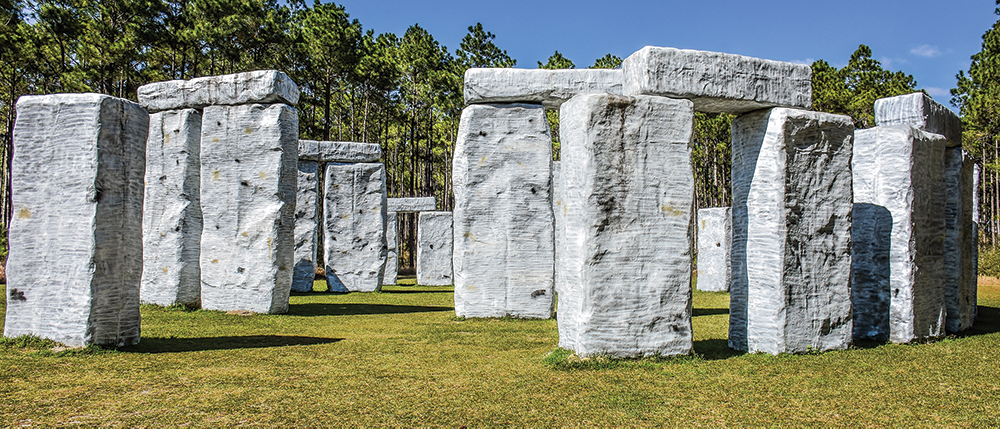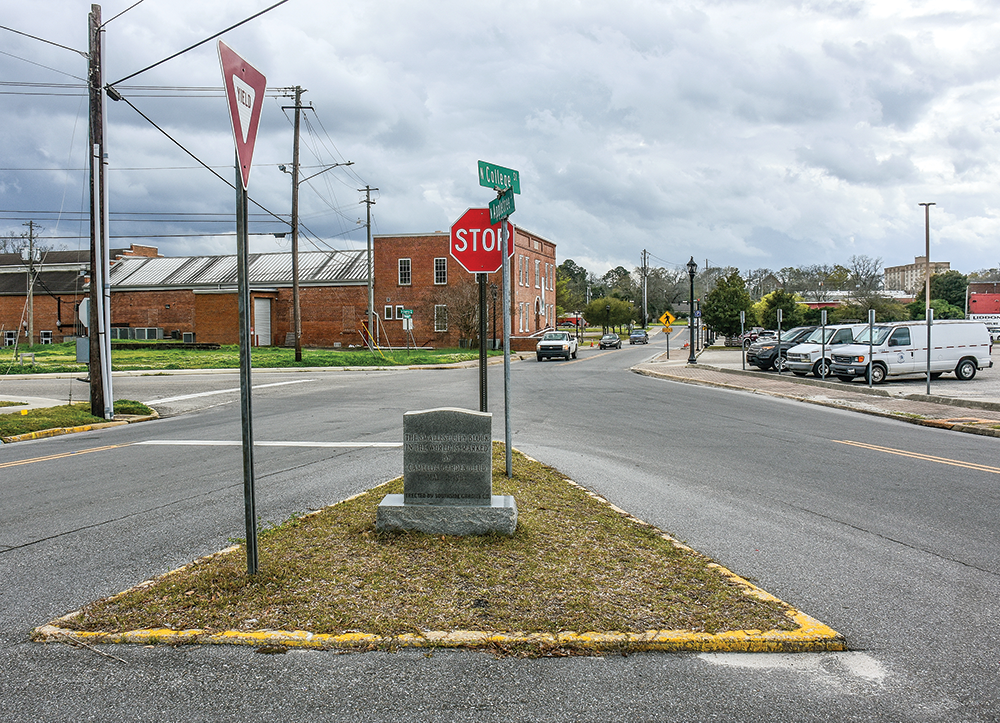By Emmett Burnett
Statues commemorate the quirkier parts of Alabama’s history
Alabama’s statues inspire us by recognizing events, people and places commemorated in stone. Other such markers are unique, thought-provoking head turners shrined in unfamiliarity.
Here are six monuments of the latter, cast in quirky while marching to the beat of a different chisel.
Space Monkey
On May 28, 1959 an explorer boarded a Jupiter Rocket, launched into space, and returned safely to earth. She was courageous; she was bold; she was a squirrel monkey. Miss Baker paved the way for human astronauts soon to follow.

Retirement was well deserved. “Miss Baker and husband George (also a squirrel monkey) moved to the Huntsville Space and Rocket Center in 1971,” recalls Patricia Ammons, the Center’s director of communications. “Children loved her and many wrote her letters.”
Sadly, the cosmos explorer, obtained by NASA from a Florida pet shop, died in 1984. Her memorial stone is at the entrance of the Rocket Center’s main museum. Visitors pay respects and leave her monument adorned with bananas.
Bamahenge
Stonehenge fascinates us. The mysterious formation is possibly a portal to time and space, the key to early man, or a road map to other worlds. The one in England is cool, too. But we are talking about the one in Josephine, Alabama, also known as “Bamahenge.”
The original required 1,500 years to build. Baldwin County’s, not quite that much.
“We installed ours in about four days,” said creator Mark Cline, owner of Enchanted Castle Studios in Virginia. “Like England’s, Bamahenge aligns with the solstice and the blocks are the same distance apart as the real one.” Built in 2012, the fiberglass rendition was commissioned by businessman George Barber and is on the Barber Parkway, near Elberta, and it may be a public service.
Cline notes, “Returning aliens may confuse the two Stonehenges – England’s and Baldwin County’s. I probably saved the planet from being taken over.”

Sylacauga’s Falling Star
On Nov. 30, 1954, a grapefruit-sized meteorite crashed through Ann Hodges’ Sylacauga roof. She is the only known person in the world to be injured by a space rock. Sylacauga’s Falling Star Monument is the only statue in the world commemorating such an event.
“The statue is based on what appeared in the sculptor’s dream,” notes Dr. Ted Spears, founder and chairman of the Sylacauga Magic of Marble Festival. Artist Don Lawler of Stephensport, Kentucky, was fascinated by Hodges’ story. Purchasing a slab of Sylacauga marble, he returned to Kentucky and chiseled “Falling Star.”
“The creation garnered little interest in Kentucky,” Spears says. “Lawler inquired if we would like to buy it and we did.” In 2009, the artist returned and erected “Falling Star” at the Sylacauga Municipal Complex. Standing about 8 feet tall, it reminds us of the wonders of space, the beauty of stars, and the night our universe opened over Talladega County and deployed a rock to attack Sylacauga.

triangle. PHOTOS BY EMMETT BURNETT
Dothan smallest block
If a Dothan resident says, “Meet me at North College and Appletree Streets,” leave the Garmin at home. You won’t need it.
The Wiregrass city has the smallest city block on earth – about 12 by 20 feet. “In the 1930s it was much larger,” recalls Dothan Mayor Mark Saliba. “Through time the block became smaller as surrounding roads grew larger.” But the tiny lot offers a lot. The diminutive plot, complete with a street and stop sign almost within arm’s length of each other, has a huge social media following and is a favorite for Facebook selfies.
An onsite marker was placed by Dothan’s Camel- lia Garden Club on May 1, 1964, noting the block’s “World’s Smallest” status. It is listed in the Guinness World Book of Records – a big award for a tiny place.

Icarus and the Guardian Angels
Y’all remember Icarus, the mythological Greek with homemade wings? He flew too close to the sun, discovered gravity is real, and crash landed in Tuscaloosa.
You heard me, T-Town, home of the Crimson Tide, Denny Chimes, and “Icarus and the Guardian Angels.” The latter includes three, 10-feet-tall figures gazing from Hackberry Lane and University Boulevard while standing before the fallen Icarus. Onlookers gaze with curiosity and few know how it got here.
“The exhibit by artist Be Gardiner was part of the Alabama Biennial sculpture competition and purchased by the University of Alabama in 1991,” recalls Rachel Dobson, of the University of Alabama’s Department of Art and Art History. It was placed on site the same year.
Icarus’ angelic Tuscaloosa security team is just that, cerebral beings watching over the body of a man who flew too close to the sun. They are his guardians – albeit too late.

Rooster Bridge
Necessity is the mother of invention, and in Demopolis, so were chickens. For in 1919 when Marengo County’s largest city needed a bridge over the Tombigbee River, the town cried fowl – roosters to be exact. Demopolis would build its bridge through the fundraising power of poultry.
The city hired Sumter County auctioneer Frank Inge Derby Sr., who theorized more money would be generated from celebrity donated roosters. But how? “It was a matter of, someone had a friend who had a friend who knew someone,” says Kirk Brooker, operations director of the Marengo County Historical Society.
Chicken donors included President Woodrow Wilson (who personally chose his bird), the President of Belgium, and prime ministers of England, France, and Italy. Other contributors included Mary Pickford, Roscoe “Fatty” Arbuckle, and U.S. Gen. John Pershing. Helen Keller donated a hen.
The bridge on U.S. Highway 80 was built in 1925 with federal money added to rooster revenue. A Demopolis Public Square marker installed in 1959 notes the Aug. 14-15, 1919 auction. According to records, crowds cheered as 600 roosters paraded through downtown Demopolis. May they roost in peace.


to Demopolis for the rooster auction. PHOTO COURTESY OF MARENGO COUNTY HISTORICAL SOCIETY

PHOTO BY EMMETT BURNETT




